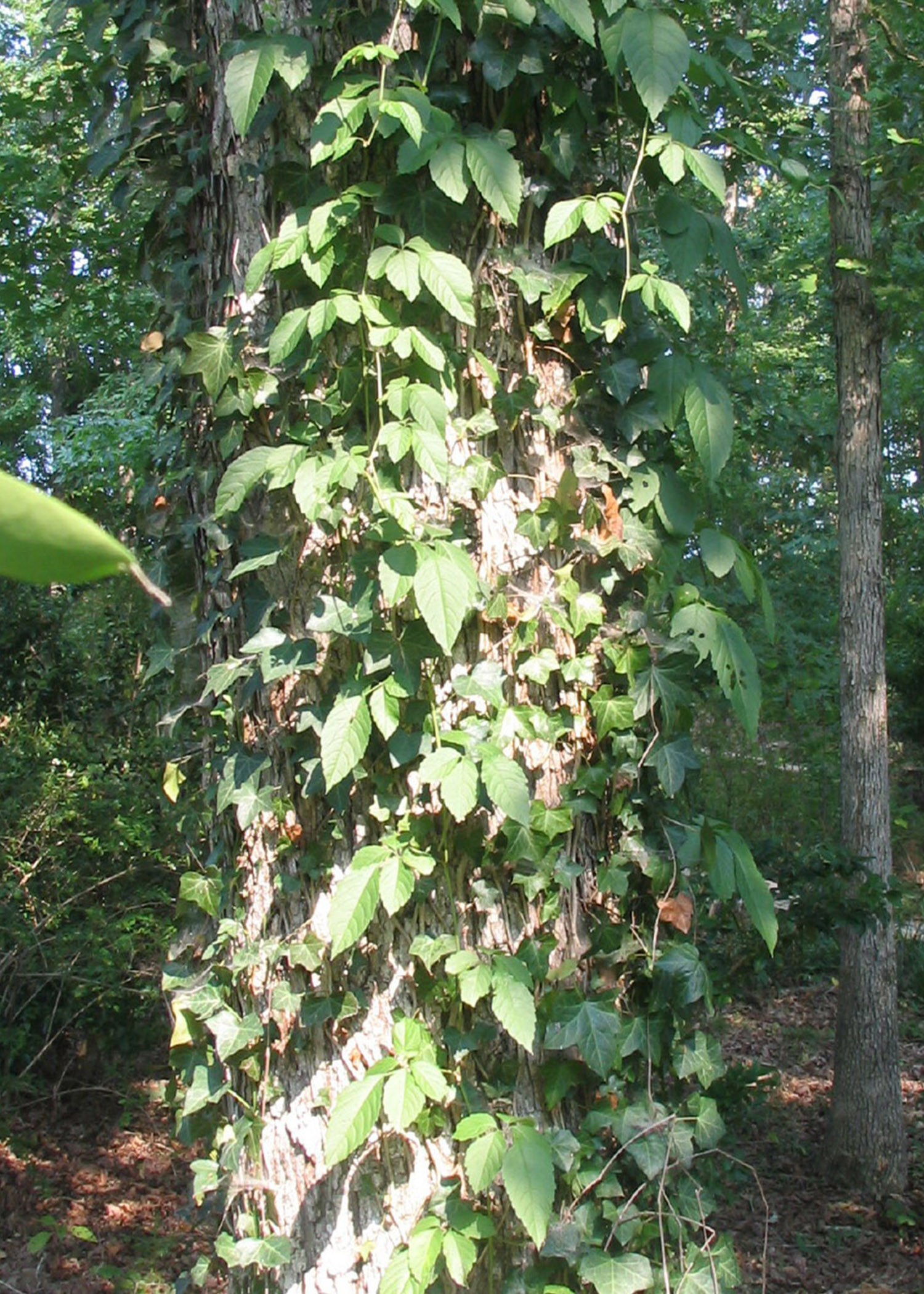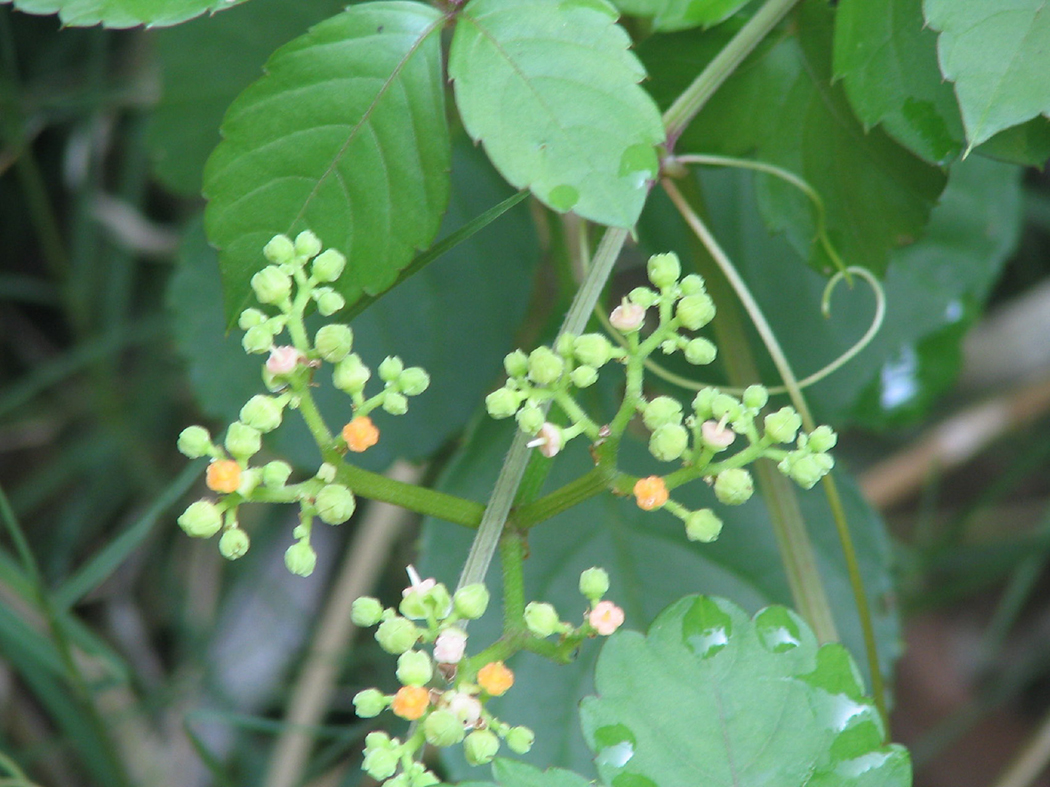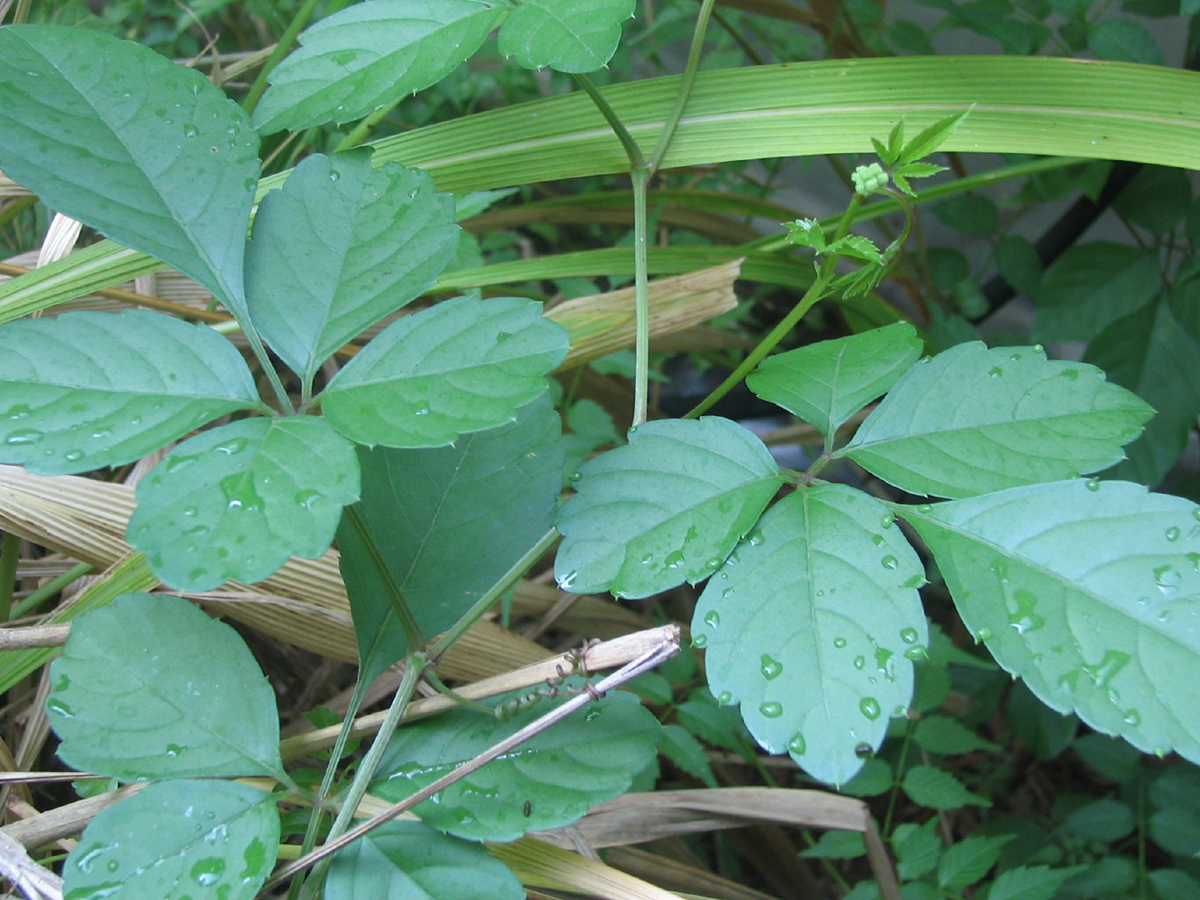Bushkiller
Bushkiller [Cayratia japonica (Thunb.) Gagnep.][Syn. Causania japonica (Thunb. ex Murray) Raf.; Cissus japonica (Thunb. ex Murray) Willd.; Cissus tenuifolia F. Heyne ex Planch.; Cissus tenuifolia F. Heyne in Wall.; Columella japonica (Thunb. ex Murray) Merr.; Vitis japonica Thunb. ex Murray; Vitis tenuifolia (F. Heyne) Laws in Hook.f.] is an evergreen to deciduous, perennial, semi-woody vine native to southeast Asia and Australia. It is found in wooded areas and landscapes.



Bushkiller climbs trees and other structures and becomes quite large in the absence of severe cold weather. Foliage can be dense, blocking or reducing the quality and quantity of sunlight to other plants. Bushkiller also competes with more desirable plants for other resources. In addition, this vine creates ladder fuel that can carry forest fires from the forest floor to tree canopies.
Bushkiller is not regulated in the United States, so it continues to spread in the South, especially in Louisiana.
Description
Vegetative Growth
Bushkiller has tendrils, similar to muscadine vines, that attach to and climb other objects or plants (Figure 1). Vines can be fleshy (Figure 2). Roots are also fleshy and produce many side shoots, especially when cut or disturbed. Leaves are compound with five leaflets and alternate arrangement of leaves. Leaves vary in size but tend to be around 5 inches long and slightly less in width. Leaflets are smooth and shiny with serrated leaf margins (Figure 3). Bushkiller is easily confused with Virginia creeper [Parthenocissus quinquefolia (L.) Planch.].
Flowering/Fruiting
The small flowers are orange- or salmon-colored and borne in flat-topped inflorescences (Figure 2). Despite an abundance of potential pollinators, bushkiller does not appear to produce viable seeds. In its native environment, bushkiller produces a two- to four-seeded berry. Since flowers are bisexual, the reason for sterility is not clear.
Dispersal Mechanisms
Production of viable bushkiller seed has not been verified in North America. It apparently only spreads vegetatively in the United States. It is spread primarily by human movement and possibly certain natural events like floods or tornadoes.
Habitat
Bushkiller is an aggressive species that could be a serious invader in the southern United States. In cooler climates, such as USDA plant hardness zone 7b, plants may freeze to the ground and regrow from underground roots in the spring.
Distribution
Bushkiller is reported in Japan, southern China, Southeast Asia, the Philippines, Taiwan, New Caledonia, New Guinea, and Queensland. Bushkiller was cultivated in the United States sometime before 1964 but has escaped in the southern United States with known occurrences in California, Louisiana, Mississippi, North Carolina, and Texas. It has survived winters in zone 7b, although foliage was severely damaged.
In the Midsouth, bushkiller occurs in Louisiana and Mississippi. In Mississippi, occurrences in new counties continue to be reported. Currently, it has been reported in Jackson, Lincoln, Tate, and Webster. In Louisiana, it occurs at scattered localities but forms dense stands in areas near the Mississippi River from Baton Rouge to New Orleans.
Control Methods
Cultural
There are no known cultural controls because bushkiller tolerates both sun and shade as well as a wide range of soil conditions. Use good sanitation procedures to remove bushkiller vegetation from tools and equipment, and burn debris to avoid spreading the plant.
Mechanical
Removal by hand may be practical for small infestations, but be careful to remove all underground plant parts to prevent re-sprouting. Burning may remove aboveground vegetation, but it will not kill plant parts underground.
Chemical
No herbicide label lists bushkiller as a target species. Recommendations for control in Table 1 were generated from limited research conducted at North Carolina State University. Large populations of bushkiller suitable for research do not exist in the United States. Aminocyclopyrachlor and imazapyr are absorbed by plant roots and can injure or kill desirable vegetation in close proximity to bushkiller populations. These herbicides should not be applied within two times the dripline of any desirable vegetation. Nonionic surfactant should be mixed with all foliar applications at the rate of 0.3 ounce per gallon of spray solution. Foliar applications should only be made when environmental conditions are favorable for active bushkiller growth.
|
Herbicide |
Formulation |
Method |
Rate |
|
Aminocyclopyrachlor |
Method |
Foliar |
0.6 oz/gallon |
|
Imazapyr |
Arsenal, Polaris, etc. |
Foliar |
2.5% solution |
|
Imazapyr + Aminocyclopyrachlor + Metsulfuron |
Viewpoint |
Foliar |
16–20 oz/A |
|
Imazapyr+Metsulfuron |
Streamline |
Foliar |
25 oz/A |
|
Sulfometuron |
Oust, SFM, etc. |
Foliar |
0.2 oz/gallon |
|
Sulfometuron + Metsulfuron |
OustExtra, SFM, Extra, etc. |
Foliar |
0.2+0.04 oz/gallon |
References
West, A.M. (2009). Biology and management of bushkiller (Cayratia japonica). Master's thesis, North Carolina State University.
USDA, NRCS. (2007). The PLANTS Database.
Publication 3191 (POD-03-24)
By John D. Byrd Jr., PhD, Extension/Research Professor, Plant and Soil Sciences; Victor Maddox, PhD, Senior Research Associate, Plant and Soil Sciences; and Randy Westbrooks, PhD, former Invasive Species Specialist, U.S. Geological Survey.
The Mississippi State University Extension Service is working to ensure all web content is accessible to all users. If you need assistance accessing any of our content, please email the webteam or call 662-325-2262.



